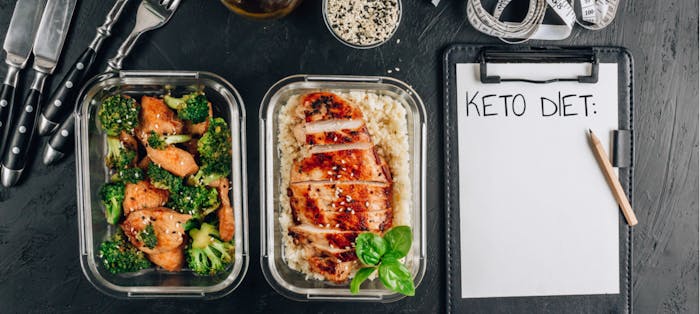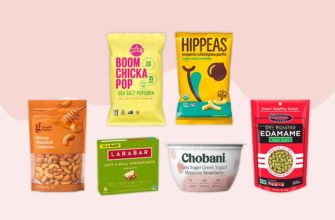In the quest for a healthier lifestyle, embarking on a ketogenic journey can be daunting. The intricacies of the diet may seem overwhelming at first, with its emphasis on low-carb, high-fat eating patterns. However, fear not! With a bit of organization and strategic planning, you can seamlessly navigate the world of keto and achieve your wellness goals.
One crucial aspect of maintaining a successful keto lifestyle lies in effective meal planning. While it may initially sound mundane and time-consuming, proactively organizing your menu can simplify your daily routine and ensure you stay on track. By taking a proactive approach to your meals and snacks, you can effortlessly maintain ketosis, optimize your energy levels, and unlock the full potential of this transformative diet.
First and foremost, it is essential to embrace the power of variety in your keto meal planning endeavors. Rather than falling into a monotonous routine, aim to experiment with a wide array of versatile ingredients. By incorporating an assortment of nutrient-rich foods into your diet, you not only diversify your nutrient intake but also prevent culinary boredom. This shift towards embracing diversity allows you to uncover a world of flavors and textures, ensuring your taste buds remain tantalized throughout your keto journey.
- Understanding the Basics of the Keto Diet
- Exploring the Fundamentals of Ketosis
- How the Body Enters Ketosis
- The Benefits of a State of Ketosis
- Cautionary Notes for Beginners
- Mastering the Macros: Tracking Your Nutrient Intake
- The Role of Fats in the Keto Diet
- Optimizing Protein Consumption
- Minimizing Carbohydrate Intake
- Smart Grocery Shopping for Keto Success
- Questions and answers
Understanding the Basics of the Keto Diet
Getting a grasp on the fundamental principles of the ketogenic diet is essential for anyone considering this popular approach to healthy eating. By understanding the core concepts, you can lay a solid foundation for successfully implementing the keto diet into your lifestyle.
What is the Keto Diet?
The ketogenic diet, often referred to as the keto diet, is a low-carbohydrate, high-fat dietary plan that has gained significant popularity in recent years. Its main goal is to shift your body’s primary fuel source from carbohydrates to fats, a process known as ketosis. By drastically reducing your intake of carbs while increasing your consumption of healthy fats, proteins, and vegetables, the keto diet aims to promote weight loss, increase energy levels, and improve overall well-being.
How Does it Work?
When you limit your intake of carbohydrates, your body is forced to seek an alternative fuel source. In the absence of carbs, it begins to break down fats into molecules called ketones. These ketones can be utilized by your body as a substitute energy source, providing fuel for your brain and muscles. This metabolic shift into ketosis not only aids in fat burning but also offers several potential health benefits, such as improved mental clarity, reduced inflammation, and stable blood sugar levels.
Benefits of the Keto Diet
While weight loss is one of the most sought-after benefits of the keto diet, there are many other advantages associated with this eating plan. By following the keto diet, individuals have reported increased energy levels, enhanced focus and concentration, decreased hunger cravings, reduced symptoms of certain health conditions like epilepsy and polycystic ovary syndrome (PCOS), and improved markers of heart health, such as lower triglyceride levels and increased levels of HDL cholesterol.
Getting Started with the Keto Diet
Adopting the keto diet requires careful planning and preparation. It is crucial to understand the various food groups to include and exclude from your meals, as well as the proper macronutrient ratios to follow. By creating a well-balanced meal plan, stocking up on keto-friendly ingredients, and gradually transitioning into ketosis, you can set yourself up for long-term success on the keto diet.
Remember, before starting any new diet or wellness program, consult with a healthcare professional or registered dietitian to ensure it is suitable for your individual needs and health conditions.
Exploring the Fundamentals of Ketosis
Delving into the core principles of ketosis involves understanding the intricate workings of this metabolic state. By embracing a low-carbohydrate, high-fat approach, individuals can train their bodies to generate energy from fats rather than carbohydrates. This shift in fuel source prompts the liver to produce ketones, which are utilized as an alternative energy source throughout the body.
One key aspect of ketosis is the restriction of carbohydrates, forcing the body to enter a state of metabolic adaptation. By severely reducing carb intake, the body is deprived of its primary source of fuel, prompting it to search for an alternative energy source. This process initiates a cascade of metabolic changes, leading to the production of ketones.
Another vital element of ketosis is the consumption of adequate amounts of healthy fats. Emphasizing sources such as avocados, olive oil, fatty fish, and nuts stimulates the body’s fat-burning ability. These fats serve as a reliable source of sustenance while ensuring that the body maintains a state of ketosis.
- Reducing carbohydrate intake
- Encouraging the consumption of healthy fats
- Initiating metabolic changes
- Promoting the production of ketones
During ketosis, the body transitions from relying on glucose from carbohydrates to utilizing fat as its primary energy source. This shift not only facilitates weight loss but may also provide other potential health benefits. Understanding the fundamentals of ketosis sets the foundation for a successful journey towards achieving and maintaining a ketogenic lifestyle.
How the Body Enters Ketosis
Understanding how the body enters a state of ketosis is essential for those following a ketogenic diet. Ketosis occurs when the body shifts from using carbohydrates as its primary fuel source to utilizing fats instead. This shift in metabolic function can have significant benefits for weight loss and overall health.
When the body enters ketosis, it begins to break down stored fats into molecules called ketones. These ketones serve as an alternative fuel source for the body and brain when carbohydrates are limited. This transition typically takes a few days to several weeks, depending on individual factors such as activity level, diet, and metabolic rate.
One of the key steps to entering ketosis is reducing carbohydrate intake. By limiting carbohydrates to a specific daily limit, typically around 20-50 grams per day, the body is forced to find an alternative fuel source. This reduction in carbohydrates prompts the liver to produce ketones from stored fats, which are then used as energy.
In addition to restricting carbohydrates, adequate protein intake is essential for maintaining muscle mass and supporting overall health during ketosis. Protein should be consumed in moderation to prevent excessive gluconeogenesis, a process where protein is converted into glucose, potentially hindering the transition into ketosis.
Another important aspect of entering ketosis is consuming sufficient dietary fats. The body needs a steady supply of fats to break down into ketones for energy. Including healthy sources of fats such as avocados, olive oil, nuts, and seeds in the diet can help facilitate the shift into ketosis.
Once the body enters a state of ketosis, it typically experiences various benefits, including improved weight loss, increased mental clarity, and enhanced energy levels. However, it’s important to note that entering ketosis may also come with temporary side effects such as the keto flu, which can include symptoms like fatigue, headaches, and irritability. Staying hydrated, getting plenty of electrolytes, and gradually transitioning into a ketogenic diet can help minimize these effects.
Overall, understanding how the body enters ketosis and implementing the necessary dietary changes can lead to a successful and simplified ketogenic diet journey.
The Benefits of a State of Ketosis
When your body enters a state of ketosis, it goes through a metabolic shift that has several positive effects on your overall health and wellness. By limiting carbohydrate intake and increasing your consumption of healthy fats, you can encourage your body to enter this state and enjoy the benefits it brings.
- Weight loss: Ketosis has been shown to facilitate weight loss by promoting the breakdown of stored fat for energy. This can lead to effective weight management and a decrease in body mass index.
- Increased energy: By relying on fat as a primary fuel source instead of carbohydrates, your body can experience sustained energy levels throughout the day. This can improve your physical and mental performance.
- Mental clarity: Many individuals report improved cognitive function and mental clarity while in a state of ketosis. This may be due to the brain’s ability to efficiently utilize ketones as an energy source.
- Stabilized blood sugar levels: Following a ketogenic diet can help regulate blood sugar levels and prevent spikes and crashes. This is particularly beneficial for individuals with diabetes or insulin resistance.
- Reduced inflammation: Ketosis has anti-inflammatory effects that can help alleviate symptoms of chronic inflammation, which is associated with various health conditions such as arthritis and metabolic syndrome.
- Appetite control: The high fat and protein content of a ketogenic diet can help promote feelings of fullness and reduce cravings, making it easier to stick to a calorie-restricted diet.
Overall, achieving a state of ketosis can offer numerous health benefits, ranging from weight loss and increased energy to improved mental function and reduced inflammation. However, it is important to note that the ketogenic diet may not be suitable for everyone, so it is essential to consult with a healthcare professional before making any significant dietary changes.
Cautionary Notes for Beginners
Before embarking on your journey into the world of ketogenic eating, it is important to be aware of a few points to ensure a successful and healthy experience.
- Proceed with caution: While the keto diet has gained popularity for its potential weight loss benefits, it may not be suitable for everyone. It is essential to consult with a healthcare professional or registered dietitian before starting any new dietary plan.
- Understanding macronutrients: The keto diet requires careful monitoring of macronutrient intake, particularly carbohydrates, fats, and proteins. Beginners should educate themselves on the proper balance of these macronutrients to maintain ketosis effectively.
- Transitioning difficulties: The initial stages of adopting a keto diet can be challenging as your body adjusts to a low-carbohydrate state. It is common to experience side effects like fatigue, headaches, and mood swings. Make sure to stay hydrated and incorporate electrolytes to minimize these symptoms.
- Avoiding nutrient deficiencies: Eliminating certain food groups, such as grains and fruits, may lead to potential nutrient deficiencies. It is crucial to vary your food choices and consider supplementation to ensure you are meeting your nutritional needs.
- Personalizing the diet: Every individual is different, and what works for one person may not work for another. It is important to listen to your body and adapt the keto diet to suit your specific needs and goals.
By keeping these cautionary notes in mind, beginners can approach the keto diet with knowledge and preparation, setting themselves up for a successful and enjoyable journey towards their health and wellness goals.
Mastering the Macros: Tracking Your Nutrient Intake
Understanding and controlling your nutrient intake is crucial for achieving success in your keto diet. By tracking macronutrients, you ensure that your body receives the right balance of carbohydrates, fats, and proteins. This section will guide you through the process of mastering the macros and show you how to effectively track your nutrient intake.
First and foremost, it is important to familiarize yourself with the macronutrients relevant to the keto diet. These include carbohydrates, fats, and proteins. Each macronutrient plays a unique role in the body and has different energy levels. By understanding their functions and proportions, you can make informed decisions about the foods you consume.
- Carbohydrates: Also known as carbs, these are your body’s primary source of energy. In the context of the keto diet, it is essential to limit your carbohydrate intake to maintain a state of ketosis – the metabolic state where your body burns fat for fuel instead of carbohydrates. Keeping track of your carb intake ensures that you don’t exceed the recommended daily limit.
- Fats: Healthy fats are a fundamental part of the keto diet. They provide sustained energy, support brain function, and promote satiety. Tracking your fat intake helps you avoid overconsumption and ensures you are getting enough to meet your daily energy needs.
- Proteins: Proteins are essential for building and repairing body tissues, maintaining muscle mass, and supporting various metabolic functions. While protein is an important component of the keto diet, it is crucial to track your intake to ensure you’re not consuming excessive amounts. Too much protein can potentially hinder ketosis by converting into glucose through a process called gluconeogenesis.
Now that you are familiar with the macronutrients, the next step is to start tracking them. There are several methods you can use to monitor your nutrient intake, including mobile apps, websites, or simply pen and paper. These tools allow you to record the food you eat along with their macronutrient content. By keeping a log of your meals, you can analyze your nutrient consumption and make adjustments as needed to stay within your desired macronutrient ratios.
Remember, mastering the macros is not about strict calorie counting, but rather about finding the right balance of macronutrients to support your keto lifestyle. It is a helpful practice to track your nutrient intake regularly, especially when starting out, as it provides valuable insights into your eating habits and helps you make informed decisions. With time, you’ll gain a better understanding of your body’s needs and be able to intuitively plan meals that align with your keto goals.
The Role of Fats in the Keto Diet

Understanding the significance of fats when following a ketogenic diet is essential for achieving optimal results. Fat plays a fundamental role in this low-carb, high-fat eating plan, providing the necessary energy and fuel for the body to function efficiently. By replacing carbohydrates with fat as the primary source of fuel, the keto diet promotes ketosis, a metabolic state where the body utilizes fats for energy instead of glucose.
Fats are more than just a means of providing energy; they also serve as a building block for crucial hormones and help absorb fat-soluble vitamins. Consuming an adequate amount of healthy fats is pivotal for the keto diet as it contributes to feeling satiated and curbing cravings. Additionally, incorporating a variety of healthy fat sources can result in a more balanced nutrient intake.
It is important to note that not all fats are created equal. While saturated and monounsaturated fats are considered favorable for the keto diet, trans fats and excessive amounts of omega-6 fatty acids should be minimized. Sources of beneficial fats include avocados, olive oil, nuts and seeds, coconut oil, and fatty fish such as salmon and tuna.
Incorporating fats into meals while following the keto diet can be done in various ways. Salads can be dressed with olive oil or avocado oil-based dressings, and dishes can be cooked using coconut oil or butter. Snacks can consist of nuts and seeds, while fatty cuts of meat and fatty fish can be enjoyed as protein sources. Emphasizing healthy fat consumption throughout the day ensures a balanced, satisfying, and sustainable keto diet.
| Beneficial Fats | Food Sources |
|---|---|
| Saturated Fats | Butter, cheese, coconut oil |
| Monounsaturated Fats | Olive oil, avocados, nuts |
| Polyunsaturated Fats | Fatty fish, flaxseeds, walnuts |
In conclusion, fats are a vital component of the keto diet, serving as a primary source of energy and providing essential nutrients. Incorporating a variety of healthy fats into meals not only contributes to feeling satisfied but also supports overall well-being when adhering to this low-carb eating plan.
Optimizing Protein Consumption

In the pursuit of a well-balanced and effective approach to the keto lifestyle, it is essential to give due consideration to optimizing protein consumption. With its vital role in maintaining muscle mass, promoting satiety, and supporting overall health, protein intake plays a crucial role in achieving weight loss and sustained wellness goals.
Maximizing Muscle Maintenance: One of the primary benefits of consuming an optimal amount of protein on the keto diet is its capability to support muscle maintenance. By providing the necessary building blocks for muscle repair and growth, protein ensures that the body sustains and even develops lean muscle mass. This aids in overall physical strength, enhances metabolism, and assists in maintaining a healthy body composition.
Appetite Control: Protein-rich foods have been proven to have a significant impact on satiety levels and appetite control. Including an adequate amount of protein in meals can help to regulate hunger hormones and prevent overeating, ultimately supporting weight loss efforts. Moreover, protein takes longer to digest than other macronutrients, thus prolonging the feeling of fullness and reducing the urge for unnecessary snacking or reaching for unhealthy food choices.
Metabolic Advantages: Protein consumption offers several metabolic advantages that can contribute to the success of the keto diet. Firstly, the thermic effect of protein refers to the energy expenditure required for digestion and absorption. Due to its higher thermic effect compared to carbohydrates and fats, protein requires more calories to process, thereby potentially increasing overall calorie expenditure. Additionally, protein can help stabilize blood sugar levels and enhance insulin sensitivity, both of which are vital for managing weight and preventing chronic diseases.
Choosing High-Quality Sources: When optimizing protein consumption on the keto diet, it is essential to prioritize high-quality sources of protein. This includes lean meats, poultry, fish, dairy products, and plant-based protein options such as legumes, tofu, and tempeh. Aim for variety in protein sources to ensure a wide array of essential amino acids and other nutrients that support optimal health and well-being.
Incorporating an appropriate amount of protein into a well-rounded keto meal plan is crucial for achieving desired results. By recognizing the benefits of protein in maintaining muscle mass, controlling appetite, and providing metabolic advantages, individuals can optimize their protein consumption and enhance their progress on the keto diet journey.
Minimizing Carbohydrate Intake

Reducing carbohydrate consumption is a key aspect of following a successful ketogenic diet. By moderating the intake of foods rich in carbohydrates, individuals can optimize their body’s ability to enter into a state of ketosis, where it burns fat for energy instead of relying on carbohydrates.
When it comes to minimizing carbohydrate intake, it is important to be mindful of the types of food you consume. Opt for whole, unprocessed foods that are low in carbohydrates, such as leafy green vegetables, lean proteins, and healthy fats. These foods not only provide essential nutrients but also help keep you feeling satisfied and energized.
One effective way to easily track and control your carbohydrate intake is by using a meal planning method. By planning your meals and snacks in advance, you can ensure that you are consuming the right amount of carbohydrates to stay within your desired range. This can be achieved by creating a weekly meal plan, making a grocery list based on low-carbohydrate options, and preparing meals in advance to avoid impulse eating.
Another helpful tip for minimizing carbohydrate intake is to read food labels carefully. Pay attention to the total carbohydrate content and note any added sugars or starchy ingredients. By familiarizing yourself with the carbohydrate content of different foods, you can make informed choices and avoid unnecessary carbohydrates in your diet.
In addition, incorporating intermittent fasting into your ketogenic lifestyle may also aid in minimizing carbohydrate intake. Intermittent fasting involves restricting your eating window to a certain number of hours each day, allowing your body to enter into a fasted state. This approach can help regulate your hunger levels and promote fat burning.
Remember, everyone’s carbohydrate needs may vary, so it’s important to listen to your body and make adjustments accordingly. Minimizing carbohydrate intake doesn’t have to be complicated – with a few simple strategies and mindful choices, you can successfully follow a keto diet and achieve your health goals.
Smart Grocery Shopping for Keto Success
Efficiently selecting the right items at the grocery store plays a crucial role in achieving success on the ketogenic diet. Making smart choices while shopping can simplify your keto journey and ensure that you stay on track with your health goals. Here are some valuable tips and suggestions to optimize your grocery shopping experience and enhance your chances of keto success.
1. Planning and Preparation: Before heading to the store, take the time to plan your meals for the week. This will help you create a detailed shopping list based on the specific ingredients needed for your keto recipes. Having a list will prevent impulsive purchases and guide you towards purchasing only keto-friendly options.
2. Focus on Whole Foods: Instead of relying heavily on processed keto products, prioritize whole foods in your shopping cart. Include fresh vegetables, quality meats, eggs, nuts, and seeds in your list. Whole foods not only provide essential nutrients but also promote better overall health.
3. Be Mindful of Carbohydrates: Pay close attention to the carbohydrate content of the items you pick. Opt for low-carb vegetables like leafy greens, broccoli, and cauliflower. Look for low-sugar options when choosing dairy products, sauces, and condiments.
4. Read Labels: Familiarize yourself with food labels to make informed choices. Avoid products with hidden sugars, artificial additives, or unhealthy fats. Aim for products with higher amounts of healthy fats, moderate protein content, and minimal carbohydrates.
5. Shop the Perimeter: The outer aisles of the grocery store typically contain fresh produce, meats, dairy, and eggs. Spend most of your time exploring these sections as they contain the majority of keto-friendly options. Limit your visits to the inner aisles, which often house processed and sugary foods.
6. Stock Up on Staples: Keep your pantry well-stocked with keto staples such as olive oil, coconut oil, almond flour, natural sweeteners, and spices. Having these essentials on hand will make it easier to whip up keto-friendly meals and snacks whenever necessary.
7. Shop with an Open Mind: Don’t be afraid to try new and unfamiliar foods. Experimenting with different keto-friendly ingredients can bring variety and excitement to your diet. Look for alternative options like cauliflower rice, zucchini noodles, or keto-friendly snacks to add diversity to your meals.
By following these smart grocery shopping tips, you can simplify the process of meal planning and set yourself up for keto success. Remember to always focus on nutrient-dense, whole foods and stay mindful of your macronutrient ratios. With proper planning and mindful choices at the store, you can easily adhere to your keto lifestyle and enjoy its many benefits.
Questions and answers
What is the Keto diet?
The Keto diet is a low-carb, high-fat diet that aims to put your body into a state of ketosis, where it burns fat for fuel instead of carbohydrates. It has been shown to help with weight loss, improve mental clarity, and increase energy levels.
How do I simplify meal planning on the Keto diet?
To simplify meal planning on the Keto diet, you can start by focusing on whole, unprocessed foods such as meat, fish, eggs, vegetables, and healthy fats. Plan your meals in advance, cook and prepare in bulk to save time, and make use of simple recipes that require minimal ingredients.
Can I still eat out while on the Keto diet?
Yes, you can still eat out while on the Keto diet. Look for restaurants that offer keto-friendly options such as salads, grilled meats or fish, and low-carb vegetable sides. Avoid foods that are breaded, fried, or contain sugary sauces. You can also customize your order by asking for substitutions or adjustments to fit your keto needs.
What are some common challenges people face with the Keto diet?
Some common challenges people face with the Keto diet include dealing with keto flu symptoms during the initial transition phase, finding suitable substitutes for high-carb foods, maintaining ketosis while dining out or attending social events, and monitoring portion sizes and macronutrient ratios to ensure you stay within your desired keto range.
Is it possible to follow the Keto diet on a budget?
Yes, it is possible to follow the Keto diet on a budget. You can focus on affordable protein sources such as eggs, chicken, and ground beef. Buy vegetables in season, purchase in bulk, and avoid expensive processed keto snacks. Meal planning and cooking at home can also help reduce costs while following the Keto diet.
Is the Keto diet difficult to follow?
Not necessarily. While it may seem daunting at first, the Keto diet can be simplified with proper meal planning and preparation. By breaking it down into simple steps, it becomes easier to follow and adhere to.
How can I simplify the Keto diet?
Simplifying the Keto diet starts with meal planning. By planning your meals in advance and focusing on simple, whole foods, it becomes easier to follow. Additionally, incorporating basic cooking techniques and using practical recipes can make the diet more manageable.
What are some simple steps for successful meal planning on the Keto diet?
There are several steps you can take to succeed in meal planning for the Keto diet. First, calculate your macronutrient needs and plan your meals accordingly. Next, create a shopping list based on your planned meals. Lastly, prep and cook your meals in bulk and portion them out for easy access throughout the week.
Can you provide some examples of simple Keto meals?
Absolutely! Some simple Keto meal examples include: a spinach salad with grilled chicken and avocado, a steak stir-fry with low-carb vegetables, or a cauliflower crust pizza with your choice of toppings. These meals are easy to prepare and are compliant with the Keto diet.
What if I have a busy schedule? Can I still succeed in meal planning for the Keto diet?
Yes, even with a busy schedule, successful meal planning for the Keto diet is possible. Consider dedicating a specific day or time each week for meal prep. You can also opt for quick and easy recipes that require minimal preparation. Additionally, utilizing kitchen tools like slow cookers or Instant Pots can save time and effort in the cooking process.

I’m Jake Morgan, a 23-year-old Keto diet and fitness expert from sunny California. Passionate about helping you achieve your dream body with the right nutrition and workout. Connect or consult via Telegram.






